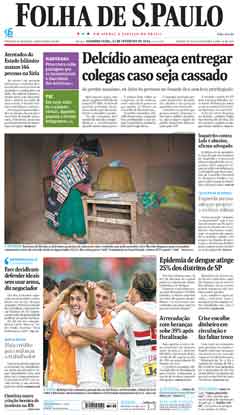Publicidade
Publicidade
Embaixador analisa impacto ambiental da pavimentação da BR-163; leia em inglês
Publicidade
DE SÃO PAULO
Id: 74817
Date: 8/14/2006 17h17
06BRASILIA1667
Embassy Brasilia
UNCLASSIFIED
VZCZCXRO0004PP RUEHAO RUEHCD RUEHGA RUEHGD RUEHGR RUEHHA RUEHHO RUEHMC RUEHNGRUEHNL RUEHQU RUEHRD RUEHRG RUEHRS RUEHTM RUEHVCDE RUEHBR #1667/01 2261717ZNR UUUUU ZZHP 141717Z AUG 06FM AMEMBASSY BRASILIATO RUEHC/SECSTATE WASHDC PRIORITY 6335INFO RUEHRI/AMCONSUL RIO DE JANEIRO 2654RUEHSO/AMCONSUL SAO PAULO 7724RUEHRG/AMCONSUL RECIFE 5271RUEHWH/WESTERN HEMISPHERIC AFFAIRS DIPL POSTSRUEHRC/USDA WASHDC
Ex-embaixador dos EUA afirma que Pará parece o 'Velho Oeste'
Veja como funciona o WikiLeaks
Veja as principais revelações do WikiLeaks
Leia a cobertura completa sobre WikiLeaks
Leia íntegra dos arquivos do WikiLeaks obtidos pela Folha
UNCLAS SECTION 01 OF 03 BRASILIA 001667 SIPDIS SIPDIS STATE PLEASE PASS TO USAID LAC/RSD EGAT STATE PLEASE PASS TO OES/ETC E.O. 12958: N/A TAGS: SENV, KSCA, EAGR, BR SUBJECT: CAN A ROAD SAVE THE AMAZON? THE BR-163 - Corrected Version BRASILIA 00001667 001.2 OF 003 REFTEL: (A) 05 BRASILIA 598, (B) 05 BRASILIA 2426
1. Summary: BR-163 is an unpaved highway located in Brazil's Amazon Forest which leads from the city of Santarem, in the state of Para, to Cuiaba, Mato Grosso. While abandoned for the past three decades, it has once again become a government priority for the development of that area. The region is home to three large hydrographic basins, and is one of the most productive agricultural areas of the country, especially in terms of soybean production. However, the road provides a challenge for the GoB to demonstrate that it can sustainably develop the Amazon and mitigate the construction's potential environmental impacts. End Summary
2. The Santarem - Cuiaba road (BR-163) was initially built in 1973 and is approximately 1,756 km long, with roughly 956 km, as of yet, unpaved. If paved, BR-163 would create a more direct route to port for the region's agricultural products, reducing transportation distances by half and representing an estimated 20% decrease in transportation costs for Brazilian soybean producers. Brazil's agricultural boom and the subsequent producer pressure to decrease shipping costs have made paving BR-163 a strategic initiative in terms of both regional and national development. In addition to agribusiness, local politicians and entrepreneurs argue that the road would facilitate the transportation of electronic products from the industrial center in Manaus to markets in the South of the country.
3. Even though there are these economic advantages to building the road, there remains significant concern of social and environmental damages associated with its construction. The first time BR-163 was built there was very little planning, which resulted in deforestation, unorganized migration and social conflicts that lead to a considerable increase in violent crime including homicides in the region. This time around, rural communities are demanding government planning in order to minimize impacts from land speculation, predatory exploitation, social violence and environmental degradation. Initial pronouncements surrounding the road's paving caused the area's population to increase by 6% between 1996 and 2000 and recent announcements about the road's future led to a 500% increase in deforestation in the towns along the BR-163. Studies show that road construction and the resulting population surplus generate land problems and, many times, uncontrolled exploitation of natural resources.
4. Related to development, land titling and speculation have been historical woes in the Amazon Basin. The process of land occupation in the region started in the 1940s. Mining, cattle ranching and logging were considered the ideal occupational activities for a location that was considered a "demographic blank" that needed to be developed and occupied. Most land occupation was done illegally, without any government control and often within Indigenous Territories. This problem has become so serious that social conflicts and human deaths have been part of the issue and continue to occur, as evidenced by the death of Dorothy Stang last year (Ref A). Unclear land tenure in the region also played and continues to play a central role in the present rate of deforestation. The lack of monitoring and government enforcement, the cheap price of land and high economic return, along with the expansion of soybean production and cattle grazing are all considered obstacles to sustainable development.
5. While paving BR-163 has become one of the Lula Administration's priorities, the GoB is attempting to avoid many of the mistakes previously made. With USAID support, local grassroots movements, NGOs and civil society organizations conducted, in 2003, a series of participatory workshops designed to discuss regional development options for the BR-163 region. This was part of the impetus behind the "Santarem Letter" which the BR-163 NGO network presented to the GoB in March 2004. The Letter outlined the actions that the GoB needed to implement in order for the paving to take place in a sustainable manner. After receiving the letter, the GoB convened a technical working group responsible for elaborating a document that establishes the actions and planning necessary for the construction of the highway.
6. In paving BR-163, the government's goal is to show that it is possible to develop the Amazon region sustainably. To this end, they have created two new policies. The first is known as the BR-163 Sustainable Plan and involved the work of 17 Brazilian ministries. The plan's initial actions include putting into practice some emergency procedures to intensify the State's presence and public authority in the region. Some of these procedures include supplementary forest inspections and raising the number of personnel in the area. Additional measures are being implemented to ensure public safety, land organization and environmental BRASILIA 00001667 002.2 OF 003 monitoring, to name a few. Compensational actions for environmental hazards and integrated policies, amongst all the states involved, for regional development are also found in the plan. The plan covers seventy one cities: 28 of them are in the state of Para, 37 in Mato Grosso and 6 in Amazonas covering a total area of 1,23 million square kilometers. This area corresponds to 24.6% of the total Legal Amazon Region and 14.47% of the nation's territory. Little of the Plan has, in fact, been put into practice, due to continued discussions concerning environmental impacts and potential complications. Many communities and NGOs fear that the plan looks good on paper, but may never be implemented.
7. Complementing the BR-163 Sustainable Plan is the Action Plan for Prevention and Control of Deforestation in the Legal Amazon, which promotes a new development model for the Amazon region based on social inclusion, cultural diversity and economic development. Sustainable use of natural resources will be encouraged through financial incentives, the implementation of environmentally sustainable structure and the recovery of degraded forest areas. In June 2006, the GoB officially implemented the 16 million hectare BR-163 forest district which utilizes the Action Plan and will incorporate Brazil's new forest concessions law (Ref B). The district will receive investments for sustainable development and production of forest products. GoB has promised to invest US$30 million in infrastructure and public land mapping for the BR-163 forest district. Economic development will proceed through managed logging and controlled utilization of forest resources. Brazil's Minister of Environment Marina Silva was quoted as saying that "building this road means that environment and development are working together."
8. The creation of the BR-163 Sustainable Plan involves not only government officials, but also the agricultural sector, NGOs, local communities and business. If the actions in the plan are actually put into practice, little resistance from local community members is likely. On the other hand, the current lack of private sector partners interested in paving the road might hamstring the project. Yet, in June, President Lula reinforced his promise to begin constructing the road saying that by the end of this year the laws with all the conditions and requirements to begin the work will be ready.
9. Nevertheless, recent events highlight how tentative BR-163 plans still are. In May 2006, Brazil's Minister of National Integration, Pedro Brito do Nascimento, announced that the Government, together with the Army Engineering Forces, would begin paving the road this year through a Public and Private Sector Partnership (PPP). Prior to the announcement, the expectation was that paving would have started in the beginning of this year. As the project will rely on funding from the private sector, many environmentalists do not believe that the road will actually be paved. Recent GoB estimates evaluate the total cost to pave BR-163 will be US$ 500 million and the project will take two to three years to conclude. The GoB once again promises that paving will now take place in the beginning of next year, sometime after the election. (Comment: Given that the GoB has yet to fully implement its December 2004 PPP framework legislation, has not put any PPP projects out for bids and has not included BR-163 on its formal listing of initial projects to be considered under the PPP framework, it's very unlikely that BR-163 will receive private funding as a PPP project any time soon. End Comment)
10. Still other events underscore the problematic nature of the paving project. Just last week, approximately 200 Indians blocked the Santa Helena to Itaba part of the BR-163 for two days. Claiming that Indigenous demands were not included in the BR-163 Sustainable plan, the tribe was demanding additional protections of their lands during the paving period. As a result of the blockade, Par and Mato Grosso were isolated and faced shortages of supplies including fuels and food. The Caiaps Indian tribe leader, Megaron Txucarramce claims that the development of cities (along BR-163) is encroaching on Indigenous Lands. The tribe is against paving BR-163 unless Indigenous land delimitation takes place before the paving begins.
11. Comment: The new sustainable economic/environment development model of the Amazon remains a controversial issue due to the enormous forest destruction that took place in the past and demands from rural and indigenous communities that still have to be considered. BR-163 could be the start of a successful development model, if its Sustainable Plan is actually implemented and the GoB has the necessary funding for its paving. Many, NGOs included, now see hope, as the GoB's efforts could provide a possible solution to the region's land speculation, deforestation and development difficulties. Paving BR-163 is definitely not the solution to all BRASILIA 00001667 003.2 OF 003 problems of the Amazon Region, but in case it works the beginning of a new phase for the sustainable management of the Forest could be starting. End Comment SOBEL
Id: 73530
Date: 8/2/2006 18h08
06BRASILIA1547
UNCLASSIFIED
Embassy Brasilia
VZCZCXRO8591OO RUEHRGDE RUEHBR #1547 2141808ZNR UUUUU ZZHO 021808Z AUG 06FM AMEMBASSY BRASILIATO RUCNDT/USMISSION USUN NEW YORK IMMEDIATE 0152RUEHC/SECSTATE WASHDC IMMEDIATE 6191INFO RUEHRG/AMCONSUL RECIFE PRIORITY 5193RUEHRI/AMCONSUL RIO DE JANEIRO PRIORITY 2562RUEHSO/AMCONSUL SAO PAULO PRIORITY 7582
UNCLAS BRASILIA 001547 SIPDIS SIPDIS FOR IO/UNP:HARRIS, USUN:OLSON, NSC:WILLIAMS-MANIGAULT, WHA/PPC:YONEOKA AND DEACON E.O. 12958: N/A TAGS: PREL, OTRA, OVIP, KSEP, UNGA, BR SUBJECT: BRAZIL: 61ST UN GENERAL ASSEMBLY: HIGH-LEVEL ATTENDANCE AND REQUESTS FOR MEETINGS - INTERIM REPORT REF: A. STATE 112656 B. BRASILIA 1429 (U) Post has not yet received information requested in reftel A from the Brazilian Foreign Ministry. Post will provide further information as it is made available.
+ Canais
+ Notícias em Poder
- Imagem de santa passa por raio-x antes de chegar a Dilma
- Câmara dos Deputados rejeita legalização dos bingos
- 'Quem aqui não teve uma namoradinha que precisou abortar?', questiona Cabral
- Discursos de despedida dominam plenário do Senado e adiam votações
- Ministério Público do Acre pede a cassação dos irmãos Viana
- 'Não tem nada mais socialista do que uma mãe', diz Lula
- Temer deixa presidência da Câmara nesta quarta-feira
- Ministro do TSE manda recontar votos do PP em quatro Estados
+ Livraria
- Box de DVD reúne dupla de clássicos de Andrei Tarkóvski
- Como atingir alta performance por meio da autorresponsabilidade
- 'Fluxos em Cadeia' analisa funcionamento e cotidiano do sistema penitenciário
- Livro analisa comunicações políticas entre Portugal, Brasil e Angola
- Livro traz mais de cem receitas de saladas que promovem saciedade
Publicidade
As Últimas que Você não Leu
Publicidade
+ LidasÍndice
- Nomeação de novo juiz do Supremo pode ter impacto sobre a Lava Jato
- Indicação de Alexandre de Moraes vai aprofundar racha dentro do PSDB
- Base no Senado exalta currículo de Moraes e elogia indicação
- Na USP, Moraes perdeu concursos e foi acusado de defender tortura
- Escolha de Moraes só possui semelhança com a de Nelson Jobim em 1997
+ Comentadas
- Manifestantes tentam impedir fala de Moro em palestra em Nova York
- Temer decide indicar Alexandre de Moraes para vaga de Teori no STF
+ EnviadasÍndice








